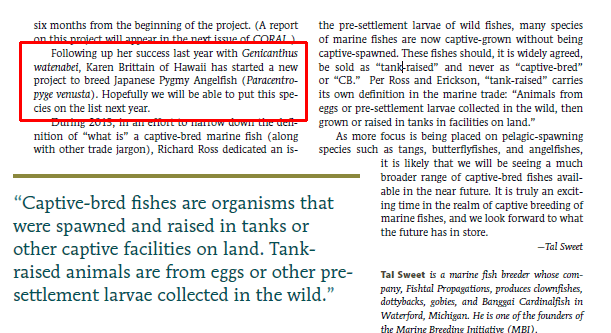In the haste to get the Jan/Feb 2014 Issue of CORAL to the printer before the holidays, we caught an error in Tal Sweet’s Captive Breeding: State of the Art 2014 report. However, it appears the error was not corrected in the version sent to the printer.

An earlier, incorrect version of the paragraph covering Karen Brittain’s 2013 projects made it into print.
Multiple errors are included in the above paragraph; Karen Brittain worked with the Japanese Pygmy Angelfish, which is Centropyge interruptus, and was first reared several years ago by Frank Baensch of Reef Culture Technologies. More recently, Brittain has started working on the pursuit of Paracentropyge venusta, which would be a new species first (she is well on here way at this time).
The correct paragraph has been included in our online version of this article.
“Following up her success last year with Genicanthus watenabei, Karen Brittain in Hawaii has continued to pursue angelfish breeding projects. She started off revisiting Reef Culture Technology’s success with Centropyge interruptus as part of her “A Girlfriend for Fabio” IndieGoGo campaign, and promising progress was made in the second half of 2013 pursuing a species first with Paracentropyge venusta. Hopefully we will be able to put the Venustus Angelfish on the list next year.”
Tal Sweet’s acknowledgements were also not printed due to space constraints; the full text included thanks to the help of Live Aquaria, ORA, Sustainable Aquatics, and Matthew Pedersen, and is included in the online version of this article as well.
When it comes to commerical and academic developments, we should further clarify that our highlights were not all meant to be conveyed as “firsts”. Most recently (12-27-2013) ORA brought to our attention that they were not the first to breed the Black Watchman Goby, Cryptocentrus fasciatus. This feat was accomplished 2 years prior (2011) by Proaquatix as noted by Matt Pedersen on ReefBuilders.
Furthermore, while Rising Tide brought attention to Green Chromis production in 2013, they were apparently not the first to rear the species successfully. While omitted from the 2013 list, it came to our attention that C. viridis had been captive bred as early as 2009, if not prior, as covered in this Marine Fisheries Information Service summary from 2009.




